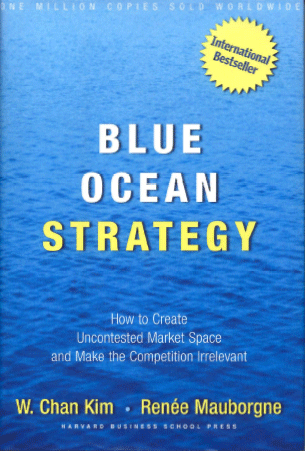Blue Ocean Strategy
 Blue Ocean Strategy (BOS) involves the simultaneous pursuit of differentiation and low cost. BOS is a leading set of growth and innovation concepts, tools, and methodologies created by business strategy professors W. Chan Kim and Renée Mauborgne of INSEAD. In 2005, Harvard Business School Press published their book entitled Blue Ocean Strategy: How to Create Uncontested Market Space and Make the Competition Irrelevant which sold over 1 million copies worldwide in its first year and has become an international bestseller, published in 41 languages.
Blue Ocean Strategy (BOS) involves the simultaneous pursuit of differentiation and low cost. BOS is a leading set of growth and innovation concepts, tools, and methodologies created by business strategy professors W. Chan Kim and Renée Mauborgne of INSEAD. In 2005, Harvard Business School Press published their book entitled Blue Ocean Strategy: How to Create Uncontested Market Space and Make the Competition Irrelevant which sold over 1 million copies worldwide in its first year and has become an international bestseller, published in 41 languages.
Link to Blue Ocean Strategy official website:
Jennifer von Briesen, Frontier Strategy's founder, is a certified Blue Ocean Strategy practitioner, and has over five years of hands-on experience applying Value Innovation and Blue Ocean Strategy methodologies at a variety of clients.
Key concepts, tools, and frameworks
1. Value Innovation
- Value Curves and the Strategy Canvas
- Four Actions Framework, and Eliminate-Reduce-Raise-Create grid
- Six Paths Framework
- Buyer Utility Map
2. Fair Process
3. Tipping Point Leadership
1. Value Innovation (the foundation of Blue Ocean Strategy)
The professors' extensive research on the sources of profitable growth led to the development of the BOS foundation concept known as Value Innovation. They analyzed 150 strategic moves in more than 30 industries over 100 years (1880-2000) and found that companies with the most profitable launches were successful because they created new market space -- new value innovations. The most successful launches involved creating new offerings with exceptional buyer value at costs well below the industry standard.
For more information on Value Innovation, here are links to some of the professors' articles in Harvard Business Review:
Blue Ocean Strategy: Reconstruct Market Boundaries
Value Innovation: The Strategic Logic of High Growth
(HBR Classic)
Creating New Market Space - systematic Six Paths Framework to discover and create new market space.
2. Fair Process
Fair Process: Managing in the Knowledge Economy
(HBR Classic)
3. Tipping Point Leadership
Blue Ocean Strategy © Kim & Mauborgne
